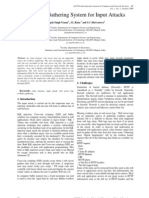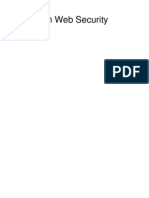0 ratings0% found this document useful (0 votes)
14 viewsWeb Server Misconfiguration: Figure 13-03 Robots
Web Server Misconfiguration: Figure 13-03 Robots
Uploaded by
Karen GarzaThe document discusses several types of web server attacks, including exploiting misconfigurations to gain unauthorized access, HTTP response splitting to redirect users to malicious websites, web cache poisoning to overwrite the server's cache with fake entries, and SSH brute-force attacks to gain access to encrypted tunnels. It also lists common web application attacks like SQL injection, session hijacking, and cross-site scripting. Finally, it covers information gathering techniques used by attackers to collect target data through social engineering, internet research, and tools to extract information from files like robots.txt.
Copyright:
© All Rights Reserved
Available Formats
Download as PDF, TXT or read online from Scribd
Web Server Misconfiguration: Figure 13-03 Robots
Web Server Misconfiguration: Figure 13-03 Robots
Uploaded by
Karen Garza0 ratings0% found this document useful (0 votes)
14 views1 pageThe document discusses several types of web server attacks, including exploiting misconfigurations to gain unauthorized access, HTTP response splitting to redirect users to malicious websites, web cache poisoning to overwrite the server's cache with fake entries, and SSH brute-force attacks to gain access to encrypted tunnels. It also lists common web application attacks like SQL injection, session hijacking, and cross-site scripting. Finally, it covers information gathering techniques used by attackers to collect target data through social engineering, internet research, and tools to extract information from files like robots.txt.
Original Description:
hacking
Original Title
CEH V10-56-7
Copyright
© © All Rights Reserved
Available Formats
PDF, TXT or read online from Scribd
Share this document
Did you find this document useful?
Is this content inappropriate?
The document discusses several types of web server attacks, including exploiting misconfigurations to gain unauthorized access, HTTP response splitting to redirect users to malicious websites, web cache poisoning to overwrite the server's cache with fake entries, and SSH brute-force attacks to gain access to encrypted tunnels. It also lists common web application attacks like SQL injection, session hijacking, and cross-site scripting. Finally, it covers information gathering techniques used by attackers to collect target data through social engineering, internet research, and tools to extract information from files like robots.txt.
Copyright:
© All Rights Reserved
Available Formats
Download as PDF, TXT or read online from Scribd
Download as pdf or txt
0 ratings0% found this document useful (0 votes)
14 views1 pageWeb Server Misconfiguration: Figure 13-03 Robots
Web Server Misconfiguration: Figure 13-03 Robots
Uploaded by
Karen GarzaThe document discusses several types of web server attacks, including exploiting misconfigurations to gain unauthorized access, HTTP response splitting to redirect users to malicious websites, web cache poisoning to overwrite the server's cache with fake entries, and SSH brute-force attacks to gain access to encrypted tunnels. It also lists common web application attacks like SQL injection, session hijacking, and cross-site scripting. Finally, it covers information gathering techniques used by attackers to collect target data through social engineering, internet research, and tools to extract information from files like robots.txt.
Copyright:
© All Rights Reserved
Available Formats
Download as PDF, TXT or read online from Scribd
Download as pdf or txt
You are on page 1of 1
Web server Misconfiguration
Another method of attack is by finding vulnerabilities in a website and exploiting
them. An Attacker may look for misconfiguration and vulnerabilities of system and
components of the web server. An attacker may identify weaknesses in terms of the
default configuration, remote functions, misconfiguration, default certificates and
debugging to exploit them.
HTTP Response Splitting Attack
HTTP Response Splitting attack the technique in which an attacker sends response
splitting request to the server. By this way, an attacker can add the header response,
resulting the server will split the response into two responses. The second response is
under control of the attacker, so user can be redirected to the malicious website.
Web Cache Poisoning Attack
Web Cache poisoning attack in a technique in which attacker wipe the actual cache of
the web server and store fake entries by sending a crafted request into the cache. This
will redirect the users to the malicious web pages.
SSH Brute-force Attack
Brite forcing the SSH tunnel will allow the attacker to use encrypted tunnel. This
encrypted tunnel is used for the communication between hosts. By brute forcing the
SSH login credentials, an attacker can gain unauthorized access to SSH tunnel.
Web Application Attacks
Other web application related attacks may include:
Cookie Tampering
DoS Attack
SQL Injection
Session hijacking
Cross-Site Request Forgery (CSRF) attack
Cross-Site Scripting (XSS) attack
Buffer overflow attack
Information Gathering
Information gathering includes a collection of information about target using different
platforms either by social engineering, internet surfing, etc. An attacker may use
different tools, networking commands for extract information. An attacker may
navigate to robot.txt file to extract information about internal files.
Figure 13-03 Robots.txt file
Page 392 of 503
You might also like
- 3.2 Web Application AttacksDocument23 pages3.2 Web Application AttacksLEOBERT CANALES JR.No ratings yet
- Typesofcyberattacks 150806095530 Lva1 App6892Document17 pagesTypesofcyberattacks 150806095530 Lva1 App6892Zeel GoyaniNo ratings yet
- Types of Cyber AttackDocument14 pagesTypes of Cyber Attackjahanzaib fazalNo ratings yet
- Server Side Web Applications AttacksDocument25 pagesServer Side Web Applications AttacksBasharat AliNo ratings yet
- Application ThreatsDocument7 pagesApplication ThreatssipraNo ratings yet
- EXPERIMENTDocument10 pagesEXPERIMENTsoni232vipinNo ratings yet
- Cyberattack Methods 1Document20 pagesCyberattack Methods 1SHOURYA BORDIANo ratings yet
- Hacking Web ServersDocument4 pagesHacking Web ServersDeandryn RussellNo ratings yet
- File 2Document33 pagesFile 2Prem PrakashNo ratings yet
- Lect 9 InvertDocument10 pagesLect 9 InvertKareem SamirNo ratings yet
- By Hari RuthalaDocument37 pagesBy Hari RuthalaRao Ali ShanNo ratings yet
- Chapter 3 - Application & Networking-Based AttacksDocument58 pagesChapter 3 - Application & Networking-Based AttacksmaryaNo ratings yet
- Understanding DDoS AttacksDocument10 pagesUnderstanding DDoS Attackstrashbinman27No ratings yet
- Web Server and Its Types of AttacksDocument6 pagesWeb Server and Its Types of AttacksAkash AryanNo ratings yet
- EHDocument3 pagesEHamii.vikrantNo ratings yet
- ETI - PPT (Application Hacking) (Autosaved)Document7 pagesETI - PPT (Application Hacking) (Autosaved)ShivaniNo ratings yet
- Cyber Security ItDocument4 pagesCyber Security ItIfrat ZawarNo ratings yet
- Welcome To International Journal of Engineering Research and Development (IJERD)Document5 pagesWelcome To International Journal of Engineering Research and Development (IJERD)IJERDNo ratings yet
- Sanctuminc HTTP AttacksDocument30 pagesSanctuminc HTTP AttacksoromosNo ratings yet
- CSE 5th ChapDocument8 pagesCSE 5th ChapSanskar RangoleNo ratings yet
- Evidence Gathering System For Input Attacks: Deepak Singh Tomar, J.L.Rana and S.C.ShrivastavaDocument4 pagesEvidence Gathering System For Input Attacks: Deepak Singh Tomar, J.L.Rana and S.C.Shrivastavavol1no1No ratings yet
- Incident HandlingDocument18 pagesIncident HandlingDijanaaaaaaNo ratings yet
- 6 Types of Cyber Attacks - JavatpointDocument6 pages6 Types of Cyber Attacks - JavatpointkumardilipNo ratings yet
- On Network AttacksDocument18 pagesOn Network AttacksSonali GoyalNo ratings yet
- Cross-Site Scripting Attacks Procedure and Prevention StrategiesDocument3 pagesCross-Site Scripting Attacks Procedure and Prevention StrategiesBront PaulNo ratings yet
- Types of Cyber AttacksDocument11 pagesTypes of Cyber AttacksSARFRAZNo ratings yet
- Ceh V10-56-6Document1 pageCeh V10-56-6Karen GarzaNo ratings yet
- Types of Attacks - Security On The Web - MDNDocument5 pagesTypes of Attacks - Security On The Web - MDNmyjobnexusNo ratings yet
- Full Path Disclosure (FPD) Vulnerabilities Enable The Attacker To See The Path To TheDocument1 pageFull Path Disclosure (FPD) Vulnerabilities Enable The Attacker To See The Path To TheIon TabanNo ratings yet
- Web Security: Different Web Application Attacks Client Side AttackDocument9 pagesWeb Security: Different Web Application Attacks Client Side AttackZain Alabeeden AlarejiNo ratings yet
- IA1701 - SE171569 - Đặng Nam Bình - LAB16Document5 pagesIA1701 - SE171569 - Đặng Nam Bình - LAB16nambinhh05No ratings yet
- Priyal Keharia Is Exp 5Document19 pagesPriyal Keharia Is Exp 5Priyal KehariaNo ratings yet
- Unit-6 - Web Application SecurityDocument32 pagesUnit-6 - Web Application Securityyototi8935No ratings yet
- V MethodsDocument29 pagesV Methodsjamal.icitNo ratings yet
- Web Security TestingDocument11 pagesWeb Security TestingHritika RawatNo ratings yet
- Web Hacking and Security - ExploitationDocument15 pagesWeb Hacking and Security - ExploitationtaperosNo ratings yet
- Sessionals 1 - Vapt Pratical Lab AssignmentDocument12 pagesSessionals 1 - Vapt Pratical Lab AssignmentCFIS 2k19No ratings yet
- 11-Access Control Structures, Firewalls.-06!05!2023Document27 pages11-Access Control Structures, Firewalls.-06!05!2023pritish.kheraNo ratings yet
- PenTest ProposalDocument8 pagesPenTest ProposalTarique MahmudNo ratings yet
- Assignemtn 2 Web EngDocument5 pagesAssignemtn 2 Web Engfaithlimbi196No ratings yet
- Interactive Detection and Classification of Ddos Attacks Using EsvmDocument7 pagesInteractive Detection and Classification of Ddos Attacks Using EsvmInternational Organization of Scientific Research (IOSR)No ratings yet
- Cross Site Request Forgery (CSRF) AttackDocument8 pagesCross Site Request Forgery (CSRF) AttackandrisurantiNo ratings yet
- Anomaly Program Data Buffer: Buffer Overflow: Buffer Overflow, or Buffer Overrun, Is AnDocument2 pagesAnomaly Program Data Buffer: Buffer Overflow: Buffer Overflow, or Buffer Overrun, Is AnmansamratNo ratings yet
- Running Head: Security Attack On Systems and Web Servers 1Document8 pagesRunning Head: Security Attack On Systems and Web Servers 1kim kimNo ratings yet
- Server-Side Request Forgery (SSRF)Document5 pagesServer-Side Request Forgery (SSRF)tusharNo ratings yet
- INJECTION_ATTACKSDocument13 pagesINJECTION_ATTACKShuahuinigNo ratings yet
- Trend ReportDocument21 pagesTrend ReportRajasekhjar MatamNo ratings yet
- Proactive Network Defence 7CS017Document15 pagesProactive Network Defence 7CS017Anchal SinghNo ratings yet
- Investigating Web ShellsDocument13 pagesInvestigating Web ShellsyuriNo ratings yet
- Must Know Hacking!3Document60 pagesMust Know Hacking!3Sinh Viên ITNo ratings yet
- Unit 1Document59 pagesUnit 1Chaudhari Pranali BharatNo ratings yet
- Running Head: Security Attack On Systems and Web Servers 1Document6 pagesRunning Head: Security Attack On Systems and Web Servers 1kim kimNo ratings yet
- FALLSEM2023-24 BCSE353E ETH VL2023240100850 2023-06-01 Reference-Material-IDocument27 pagesFALLSEM2023-24 BCSE353E ETH VL2023240100850 2023-06-01 Reference-Material-Idsa dsaNo ratings yet
- Broken Web SecurityDocument87 pagesBroken Web SecurityBo BeanNo ratings yet
- Vulnerabilities Found On WebsitesDocument4 pagesVulnerabilities Found On WebsitesAl RaficNo ratings yet
- Common Web Security ThreatsDocument41 pagesCommon Web Security ThreatsBenoy BoseNo ratings yet
- Lectre 13Document6 pagesLectre 13AkRajNo ratings yet
- Security+ 601 Test 2Document61 pagesSecurity+ 601 Test 2Kalen StarNo ratings yet
- Hacking Web ApplicationsDocument5 pagesHacking Web ApplicationsDeandryn RussellNo ratings yet
- Advantages Disadvantages: 3. Stateful Multilayer Inspection FirewallDocument2 pagesAdvantages Disadvantages: 3. Stateful Multilayer Inspection FirewallKaren GarzaNo ratings yet
- Back To Windows Server 2016 and Observe The LogsDocument1 pageBack To Windows Server 2016 and Observe The LogsKaren GarzaNo ratings yet
- Types of Honeypots 1. High-Interaction HoneypotsDocument2 pagesTypes of Honeypots 1. High-Interaction HoneypotsKaren GarzaNo ratings yet
- Patch Management: Patches and HotfixesDocument1 pagePatch Management: Patches and HotfixesKaren GarzaNo ratings yet
- MBSA Will First Get Updates From Microsoft, Scan, and Then Download The Security UpdatesDocument1 pageMBSA Will First Get Updates From Microsoft, Scan, and Then Download The Security UpdatesKaren GarzaNo ratings yet
- Ceh V10-58-7Document1 pageCeh V10-58-7Karen GarzaNo ratings yet
- Chapter 12: Evading IDS, Firewall and HoneypotsDocument1 pageChapter 12: Evading IDS, Firewall and HoneypotsKaren GarzaNo ratings yet
- Fragmentation Attack: Denial-Of-Service Attack (Dos)Document2 pagesFragmentation Attack: Denial-Of-Service Attack (Dos)Karen GarzaNo ratings yet
- Enter The Query The Server/buttonDocument1 pageEnter The Query The Server/buttonKaren GarzaNo ratings yet
- Ceh V10-52-2Document1 pageCeh V10-52-2Karen GarzaNo ratings yet
- Ceh V10-52-1Document1 pageCeh V10-52-1Karen GarzaNo ratings yet
- Lab 13-1: Web Server Footprinting Using ToolDocument1 pageLab 13-1: Web Server Footprinting Using ToolKaren GarzaNo ratings yet
- Evading Firewalls: Firewall IdentificationDocument2 pagesEvading Firewalls: Firewall IdentificationKaren GarzaNo ratings yet
- Ceh V10-56-6Document1 pageCeh V10-56-6Karen GarzaNo ratings yet
- Web Application Concepts: Server AdministratorDocument1 pageWeb Application Concepts: Server AdministratorKaren GarzaNo ratings yet
- Go To Windows 7 Machine 5. Open Command Prompt 6. Generate Some Traffic Like FTPDocument1 pageGo To Windows 7 Machine 5. Open Command Prompt 6. Generate Some Traffic Like FTPKaren GarzaNo ratings yet
- IIS Web Server Architecture: Components of IIS Protocol ListenerDocument1 pageIIS Web Server Architecture: Components of IIS Protocol ListenerKaren GarzaNo ratings yet
- ARM Assembly Programming Using Raspberry Pi GUI PDFDocument23 pagesARM Assembly Programming Using Raspberry Pi GUI PDFKaren GarzaNo ratings yet
- Evading Firewalls: Firewall IdentificationDocument2 pagesEvading Firewalls: Firewall IdentificationKaren GarzaNo ratings yet
- Fragmentation Attack: Denial-Of-Service Attack (Dos)Document2 pagesFragmentation Attack: Denial-Of-Service Attack (Dos)Karen GarzaNo ratings yet
- Chapter 13: Hacking Web Servers: Technology BriefDocument1 pageChapter 13: Hacking Web Servers: Technology BriefKaren GarzaNo ratings yet
- Lab 13-1: Web Server Footprinting Using ToolDocument7 pagesLab 13-1: Web Server Footprinting Using ToolKaren GarzaNo ratings yet
- Hacking Windows Phone OSDocument7 pagesHacking Windows Phone OSKaren GarzaNo ratings yet
- CEH v10 Module 21 - References ESDocument7 pagesCEH v10 Module 21 - References ESKaren GarzaNo ratings yet
- Security Operations Analysis r8pndlDocument79 pagesSecurity Operations Analysis r8pndlKaren Garza100% (1)

















































































